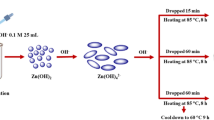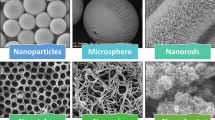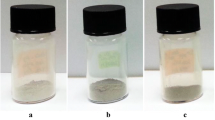Abstract
In the current study describes the synthesis, characterization, and photocatalytic activity (PCA) of ZnO nanoparticles (NPs) synthesized via the polymeric precursor technique in the first step, following annealing ranging from 500 to 900 °C in a second step. X-ray diffraction data analysis confirms the formation of the wurtzite crystal structure in the as-prepared and thermally annealed samples. To adjust the crystallite mean size and physical properties, thermal annealing procedures in atmospheric air are used. The UV–Vis spectroscopy studies show that the optical band gap of the as-fabricated ZnO NPs decreases monotonically, from ~ 3.4 eV to ~ 3.1 eV, as the annealing temperature increases. The PCA of the ZnO NPs against methylene blue dye tests revealed an increase in efficiency as the annealing temperature increases from 500 °C, reaching a maximum performance for the sample annealed at 700 °C. Above that annealing temperature, the efficiency tends to slightly decrease. Our findings suggest that the PCA tests of the ZnO NPs do not show a straightforward dependence on the NPs’ size, but it seems to be correlated with the density of defects, such as oxygen vacancies, which are modulated by the annealing temperature. In addition, thermoluminescence (TL) glow curves exhibit a well-defined peak located at ~ 622 K for the as-prepared ZnO NPs. The TL peak intensity shows a decreasing trend with the annealing temperature up to ~ 700 °C. This result was correlated with the modulation of charge traps as the annealing temperature is increased. It means, the TL peak intensity is directly related to the amount of trapped charges (electrons and holes); therefore, a more intense TL peak suggests less photogenerated charge available for the catalytic activity, leading to a marked reduction of the PCA.
Graphical abstract









Similar content being viewed by others
References
A. Di Mauro, M. E. Fragalà, V. Privitera, and G. Impellizzeri, “ZnO for application in photocatalysis: From thin films to nanostructures,” Materials Science in Semiconductor Processing, vol. 69, pp. 44–51, 2017/10/01/ 2017.
A. Janotti and C. G. Van de Walle, “Native point defects in ZnO,” Physical Review B, vol. 76, p. 165202, 2007.
A. J. J. Bos, “Theory of thermoluminescence,” Radiation Measurements, vol. 41, pp. S45-S56, 2006/12/01/ 2006.
A. K. Zak, M. E. Abrishami, W. H. A. Majid, R. Yousefi, and S. M. Hosseini, “Effects of annealing temperature on some structural and optical properties of ZnO nanoparticles prepared by a modified sol–gel combustion method,” Ceramics International, vol. 37, pp. 393–398, 2011/01/01/ 2011.
A. P. Piedade, A. C. Pinho, R. Branco, and P. V. Morais, “Evaluation of antimicrobial activity of ZnO based nanocomposites for the coating of non-critical equipment in medical-care facilities,” Applied Surface Science, vol. 513, p. 145818, 2020/05/30/ 2020.
Cai X, Huang Y, Hu J, Zhu S, Tian X, Zhang K, Ji G, Zhang Y, Fu Z, Tan C (2020) Tuning photocatalytic performance of multilayer ZnO for water splitting by biaxial strain composites. Catalysts 10:1208
D. A. Yaseen and M. Scholz, “Textile dye wastewater characteristics and constituents of synthetic effluents: a critical review,” International Journal of Environmental Science and Technology, vol. 16, pp. 1193–1226, 2019/02/01 2019.
D. G. Pacheco-Salazar, F. H. Aragon, L. Villegas-Lelovsky, A. Ortiz de Zevallos, G. E. Marques, and J. A. H. Coaquira, “Engineering of the band gap induced by Ce surface enrichment in Ce-doped SnO2 nanocrystals,” Applied Surface Science, vol. 527, p. 146794, 2020.
D. Heger, J. Jirkovský, and P. Klán, “Aggregation of Methylene Blue in Frozen Aqueous Solutions Studied by Absorption Spectroscopy,” The Journal of Physical Chemistry A, vol. 109, pp. 6702–6709, 2005/08/04 2005.
Galdámez-Martinez A, Santana G, Güell F, Martínez-Alanis PR, Dutt A (2020) Photoluminescence of ZnO nanowires: a review. Nanomaterials 10:857
H. A. Borbón-Nuñez, C. Cruz-Vázquez, R. Bernal, G. Kitis, C. Furetta, and V. M. Castaño, “Thermoluminescence properties of sintered ZnO,” Optical Materials, vol. 37, pp. 398–403, 2014/11/01/ 2014.
H. Sudrajat and P. Sujaridworakun, “Correlation between particle size of Bi2O3 nanoparticles and their photocatalytic activity for degradation and mineralization of atrazine,” Journal of Molecular Liquids, vol. 242, pp. 433–440, 2017/09/01/ 2017.
Huang J, Yin Z, Zheng Q (2011) Applications of ZnO in organic and hybrid solar cells. Energy Environ Sci 4:3861–3877
I. Daou, O. Zegaoui, and A. Elghazouani, “Physicochemical and photocatalytic properties of the ZnO particles synthesized by two different methods using three different precursors,” Comptes Rendus Chimie, vol. 20, pp. 47–54, 2017/01/01/ 2017.
J. Wang, Z. Wang, B. Huang, Y. Ma, Y. Liu, X. Qin, X. Zhang, and Y. Dai, “Oxygen vacancy induced band-gap narrowing and enhanced visible light photocatalytic activity of ZnO,” ACS Applied Materials & Interfaces, vol. 4, pp. 4024–4030, 2012/08/22 2012.
Kayaci F, Vempati S, Donmez I, Biyikli N, Uyar T (2014) Role of zinc interstitials and oxygen vacancies of ZnO in photocatalysis: a bottom-up approach to control defect density. Nanoscale 6:10224–10234
K. Paździor, L. Bilińska, and S. Ledakowicz, “A review of the existing and emerging technologies in the combination of AOPs and biological processes in industrial textile wastewater treatment,” Chemical Engineering Journal, vol. 376, p. 120597, 2019/11/15/ 2019.
Kuriakose S, Satpati B, Mohapatra S (2014) Enhanced photocatalytic activity of Co doped ZnO nanodisks and nanorods prepared by a facile wet chemical method. Phys Chem Chem Phys 16:12741–12749
M Montero-Muñoz 2018 Estudo dos mecanismos de formação de estruturas de ZnO com diferentemorfologia e a sua influência na eficiência da atividade fotocatalítica sobre moléculas orgânicas University of Brasilia PhD-Thesis
M. Montero-Muñoz, J. E. Ramos-Ibarra, J. E. Rodríguez-Páez, M. D. Teodoro, G. E. Marques, A. R. Sanabria, P. C. Cajas, C. A. Páez, B. Heinrichs, and J. A. H. Coaquira, “Role of defects on the enhancement of the photocatalytic response of ZnO nanostructures,” Applied Surface Science, vol. 448, pp. 646–654, 2018/08/01/ 2018.
M. Pudukudy and Z. Yaakob, “Facile synthesis of quasi spherical ZnO nanoparticles with excellent photocatalytic activity,” Journal of Cluster Science, vol. 26, pp. 1187–1201, 2015/07/01 2015.
Montero-Muñoz M, Ramos-Ibarra JE, Rodríguez-Páez JE, Marques GE, Teodoro MD, Coaquira JAH (2020) Growth and formation mechanism of shape-selective preparation of ZnO structures: correlation of structural, vibrational and optical properties. Phys Chem Chem Phys 22:7329–7339
M. Puchalska and P. Bilski, “GlowFit—a new tool for thermoluminescence glow-curve deconvolution,” Radiation Measurements, vol. 41, pp. 659–664, 2006/07/01/ 2006.
N. Dilmi, N.-E. Bacha, and A. Younes, “Structural and magnetic properties of Fe60–xNix(ZnO)40 nanocomposites produced by mechanical milling and coated by thermal spraying on a steel substrate,” Powder Metallurgy and Metal Ceramics, vol. 59, pp. 35–45, 2020/05/01 2020.
N. Jayarambabu, Kumari, K. Rao, and Y. Prabhu, “BENEFICIAL ROLE OF ZINC OXIDE NANOPARTICLES ON GREEN CROP PRODUCTION,” INTERNATIONAL JOURNAL OF MULTIDISCIPLINARY ADVANCED RESEARCH TRENDS, vol. 2, pp. 2349–7408, 2015.
N. R. J. Hynes, J. S. Kumar, H. Kamyab, J. A. J. Sujana, O. A. Al-Khashman, Y. Kuslu, A. Ene, and B. Suresh Kumar, “Modern enabling techniques and adsorbents based dye removal with sustainability concerns in textile industrial sector -a comprehensive review,” Journal of Cleaner Production, vol. 272, p. 122636, 2020/11/01/ 2020.
N. Verma, S. Bhatia, and R. K. Bedi, “Effect of annealing temperature on ZnO nanoparticles and its applications for photocatalytic degradation of DR- 31 dye,” International Journal of Pure and Applied Physics. ISSN 0973–1776, vol. 13, pp. 118–122, 2017.
Ostwald W (1896) Lehrbuch der Allgemeinen Chemie. Bd. 2. Stöchiometrie 2:705–742
O. Mekasuwandumrong, P. Pawinrat, P. Praserthdam, and J. Panpranot, “Effects of synthesis conditions and annealing post-treatment on the photocatalytic activities of ZnO nanoparticles in the degradation of methylene blue dye,” Chemical Engineering Journal, vol. 164, pp. 77–84, 2010/10/15/ 2010.
P. e. a. Gonçalves, “Evaluation of the photocatalytic potential of TiO2 and ZnO obtained by different wet chemical methods.,” Materials Research, vol. 20, pp. 181–189, 2017.
R. Raji and K. G. Gopchandran, “ZnO nanostructures with tunable visible luminescence: effects of kinetics of chemical reduction and annealing,” Journal of Science: Advanced Materials and Devices, vol. 2, pp. 51–58, 2017/03/01/ 2017.
V. Srikant and D. R. Clarke, “On the optical band gap of zinc oxide,” Journal of Applied Physics, vol. 83, pp. 5447–5451, 1998/05/15 1998.
SWS McKeever 1985 Thermoluminescence of solids Cambridge Uni. Press Cambridge
Toby B (2001) EXPGUI, a graphical user interface for GSAS. J Appl Crystallogr 34:210–213
Y. Kang, F. Yu, L. Zhang, W. Wang, L. Chen, and Y. Li, “Review of ZnO-based nanomaterials in gas sensors,” Solid State Ionics, vol. 360, p. 115544, 2021/02/01/ 2021.
Z.-Y. Zhang, “Strain engineering for ZnO nanowires: first-principle calculations,” Physics Letters A, vol. 378, pp. 1174–1179, 2014/03/14/ 2014.
Acknowledgements
The authors (FFHA, JCRA, JAHC, JLS, and DGPS) thank the financially support by the CONCYTEC-PROCIENCIA within the framework of the call E038-01 [contract No 07-2019-FONDECYT-BM-INC. INV]. JAHC thanks the financial support from the Brazilian agencies CNPq (303182/2020-2) and FAPDF (00193-00000151/2019-20). PCM thanks CNPq for financial support.
Author information
Authors and Affiliations
Corresponding author
Ethics declarations
Conflict of interest
The authors declare that they have no conflict interest.
Additional information
Publisher's note
Springer Nature remains neutral with regard to jurisdictional claims in published maps and institutional affiliations.
Supplementary Information
Below is the link to the electronic supplementary material.
Rights and permissions
About this article
Cite this article
Andia-Huaracha, S.C., Zapana-Cayo, L.M., Aragón, F.F.H. et al. Tuning the photocatalytic activity of ZnO nanoparticles by the annihilation of intrinsic defects provoked by the thermal annealing. J Nanopart Res 24, 50 (2022). https://doi.org/10.1007/s11051-022-05421-7
Received:
Accepted:
Published:
DOI: https://doi.org/10.1007/s11051-022-05421-7




